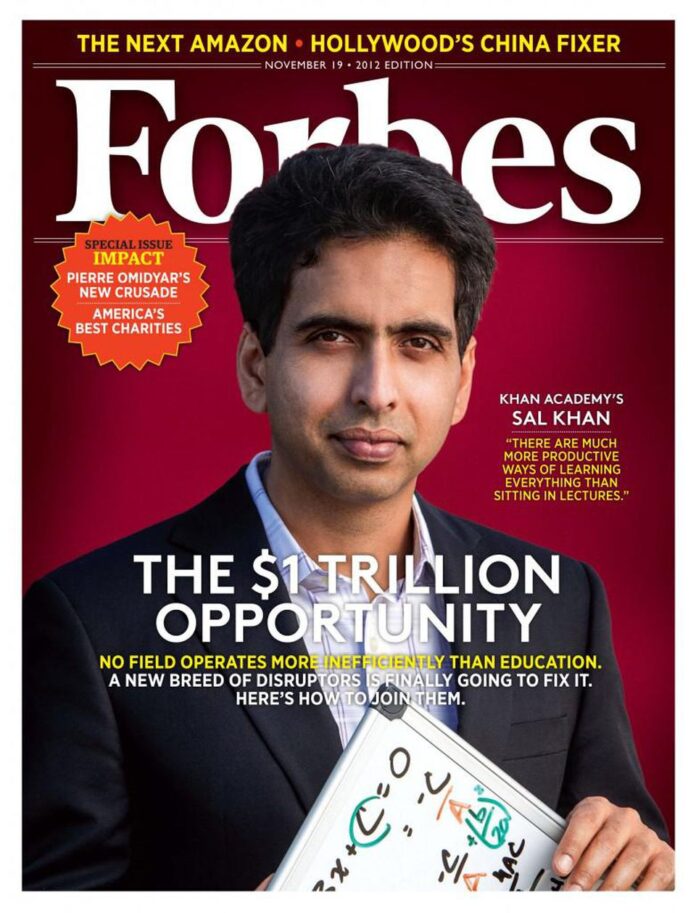Khan Academy is a great example of the positive power and inclusivity that online education can have. It may not necessarily be a substitute for school, but it is certainly widening the accessibility of quality educational content to an extremely wide audience, and for FREE. Khan Academy is a non-profit, so all of its backing comes from various investors and donors. And with this platform, he is able to reach millions of people.
The model of Khan Academy is certainly helping people learn in a individualized and customizable move-at-your-own-pace platform that is only really possible online. How is Khan’s platform and others like it changing the idea of the traditional educational model, and how might it continue to do so?
—
Noer, Michael. “One Man, One Computer, 10 Million Students: How Khan Academy Is Reinventing Education.” Forbes, 2 Nov 2012, https://www.forbes.com/sites/michaelnoer/2012/11/02/one-man-one-computer-10-million-students-how-khan-academy-is-reinventing-education/#2acb283444e0.
“It’s a prototypical Silicon Valley ethos, with one exception: The Khan Academy, which features 3,400 short instructional videos along with interactive quizzes and tools for teachers to chart student progress, is a nonprofit, boasting a mission of “a free world-class education for anyone anywhere.”
“About a fifth of American 15-year-olds do not have basic competence in science; 23% can’t use math in daily life. It’s those latter statistics that motivate Khan. The site covers a staggering array of topics–from basic arithmetic and algebra to the electoral college and the French Revolution. The videos are quirky affairs where you never see the instructor (usually Salman Khan himself, who personally has created nearly 3,000 of them). Instead, students are confronted with a blank digital blackboard, which, over the course of a ten-minute lesson narrated in Khan’s soothing baritone, is gradually filled up with neon-colored scrawls illustrating key concepts.”
“Over the past two years Khan Academy videos have been viewed more than 200 million times. The site is used by 6 million unique students each month (about 45 million total over the last 12 months), who have collectively solved more than 750 million problems (about 2 million a day), and the material, which is provided at no cost, is (formally or informally) part of the curriculum in 20,000 classrooms around the world. Volunteers have translated Khan’s videos into 24 different languages”
“Khan’s meteoric success has attracted the financial support of a bevy of high-profile, socially minded backers. . . In total Khan has raised $16.5 million, with assurances of more to come.
“”The numbers get really crazy when you look at the impact per dollar,” says Khan. “We have a $7 million operating budget, and we are reaching, over the course of a year, about 10 million students in a meaningful way. If you put any reasonable value on it, say $10 a year–and keep in mind we serve most students better than tutoring–and you are looking at, what, a 1,000% return?”
“But Salman Khan’s ambitions go much further. “Now that there are these tools, where students can learn at their own pace and master the concepts before moving on, can we rethink this educational model that has been standard practice for hundreds of years?”
“Internet-based technology long ago figured out how to revolutionize and democratize everything from retail to auctions to maps. So what took so long to disrupt perhaps the largest, most dysfunctional field of all? With education several things were needed that until this decade hadn’t materialized: widespread broadband, low content costs (both creation and distribution) and rapidly proliferating mobile devices. And just as critically, a shift in social norms that accepts the efficacy of online learning coupled with a generation of digital natives willing to wholeheartedly embrace it. And this perfect storm is finally attracting investment.”
“The biggest opportunities of all may be in the developing world. Although broadband connectivity is more limited there than in richer countries, it is far from nonexistent, and ultracheap tablets like the $40 Aakash are starting to come to market. That makes alternative delivery systems possible. Dozens of Khan Academy videos, for instance, could fit on a single thumb drive.
“”This decade is the first opportunity we have ever had to extend quality secondary education to every kid on the planet,” says Tom Vander Ark, a venture capitalist who headed the Bill & Melinda Gates Foundation’s educational programs through 2006. “When you combine mobile devices, free content and an inexpensive, blended learning model, you can serve kids in the slums of Nairobi for $4 a month and you can start to imagine a $100-a-year high school that is quite high quality.””
“”We have a one-size-fits-all, one-speed-fits-all, one-path-fits-all model,” says Thrun. “And that is the result of one simple assumption that we are questioning. The assumption is that education takes place from teacher to student by spoken word–by synchronous, not recorded, spoken word. That means that all the students have to be at the same place at the same time. If everyone really learned at the same speed on the same path then you could fill a stadium and still have useful learning. But you can’t.”




